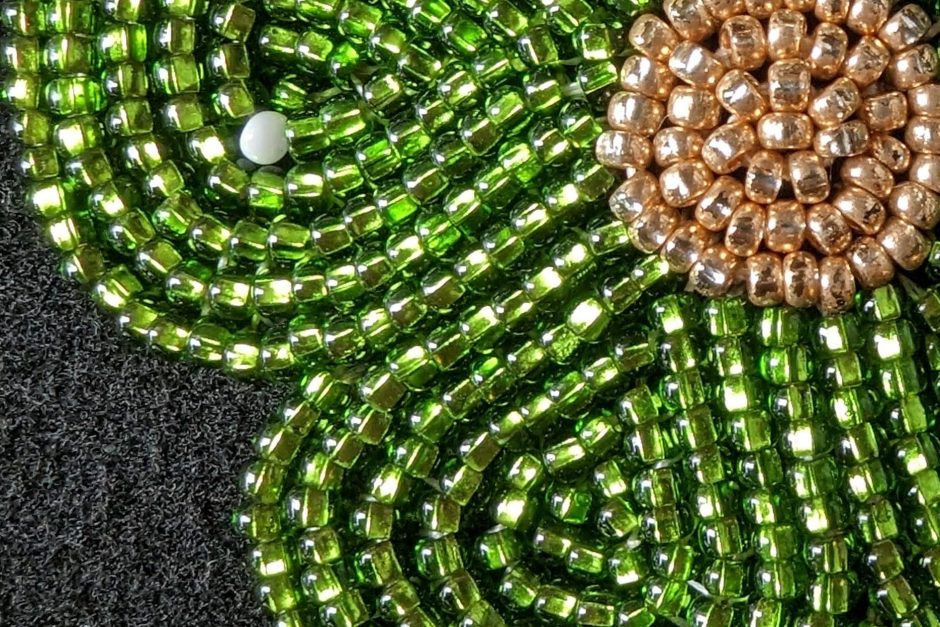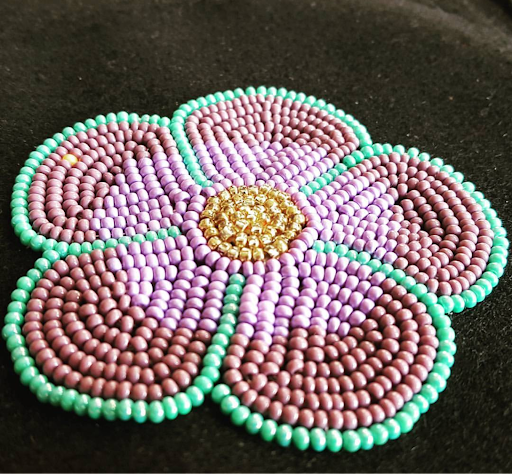
Beading Our Way Home: Youth Photo-Voice Project
What is the Beading Our Way Home project?
The Beading Our Way Home: Youth PhotoVoice Project explored the experiences of Métis youth engaging in Métis culture through side by side beadwork with a Métis knowledge carrier to support the health, well-being, and resilience of Métis youth.
This project aims to contribute to the enhancement of wellbeing and help develop, improve, and sustain community-based cultural programs for Indigenous children and youth. The knowledge generated from this project may be able to enhance the awareness and recognition of the importance of cultural programming for Métis youth, including children and youth in the Canadian child welfare system. Findings may be able to guide service providers in providing culturally appropriate and meaningful services for Métis children and youth.
Guiding Questions
- What is the experience of participating in traditional Métis beadwork for Indigenous youth?
- How do learners make meaning of the experience in relation to their Métis identity?
- How do Métis youth describe their cultural connection after participating?
What did we do
Through various community engagement activities at Métis Family Services, youth were invited to participate in the project.
Youth involved with Métis Family Services were invited to participate in 8, 1-hour, one-on-one beadwork sessions. Two youth siblings met together for sessions. The first 2 youth had online sessions due to the COVID-19 pandemic. The remaining 8 youth met in-person at a local library or recreation centre for the sessions. 10 youth participated in the sessions and 8/10 youth had never learned beadwork prior to the sessions. The sessions occurred between February 2022- March 2023.

Métis knowledge holder and artist, Lisa Shepherd, met with each youth. Lisa is actively involved and connected to the Métis community and has a personal commitment to sharing her knowledge with Métis youth.
Youth were mailed beading kits along with a journal to write in.

After completing the beadwork sessions, each youth was invited to photograph objects, events, places, or people that represented their meaning of connecting to culture through beadwork. Researcher, Cheryl Inkster, met with each youth for an interview to learn about their photos and ask them about their experiences participating in the beadwork sessions.
Why?
The Métis way of life had been disrupted due to colonial violence and White settlement in Canada (1). The Red River Métis were forced to leave their community in the 1870’s and 80’s and this disrupted their way of life.
Another attempt to get rid of Métis peoples was through residential schools. The Truth and Reconciliation Commission’s final report outlines how the residential school experience of Métis children has been overlooked (2). This displacement of Métis families through residential schools is often unknown outside of the Métis community. It is important to know this context when understanding the Métis experience and when designing services for Métis children and families (1). The Truth and Reconciliation Commission created a separate volume for the often-overlooked experience of Métis children who were sent to the schools (2). The report noted that “the harm done to the children, their parents, and the Métis community was substantial. It is an ongoing shame that this damage has not been addressed and rectified” (2, p. 55).
This project responds to several of the Truth and Reconciliation Commission Calls to Action (3), the United Nations Declaration on the Rights of Indigenous Peoples (4), and honors the children who both attended and died in residential schools. Children were forbidden from learning and practicing their culture and this project takes a step towards connecting Métis children with their culture.
Métis People & Research
There is an under-representation of Métis people in research on Indigenous peoples in Canada and there are several gaps in the existing health and wellbeing research specifically related to health programming, mental health, and social determinants of health (5). There is minimal literature on Métis experiences in child welfare systems (6). A large proportion of research is pan-Indigenous and does not provide Métis specific findings (5). Confusion over who the Métis people are affects their representation in research and in service delegation in Métis communities (1).
Culture & Resilience
Engaging in Indigenous cultural activities has been found to impact one’s cultural identity and mental health (7-10). Using an ecological definition of resilience (11), it is suggested that a move be made from focusing on what individuals need to change to what aspects of the social ecology need to change for individuals to adopt new coping patterns. Applying this definition to this project, what aspects of Métis child welfare programming need to change for Métis youth to adopt new ways of coping and build their resilience?
The Flower Beadwork People

Métis people are known for their floral beadwork, with beadwork being a time to come together, share stories, and focus on beading and creating a sense of community (12). Various authors have discussed identity and wellness for Indigenous people engaging in traditional beadwork (13-17). Beads play an important role in repairing cultural ties and represent Indigenous resiliency (15).
Studies are lacking which extend the exploration of culture and wellbeing to the specific experience of Métis youth engaging in traditional Métis beadwork.
Métis artist Christi Belcourt (13) describes beadwork as an expression of identity and as a “healing art.” Techniques and patterns have been passed down through generations and are still being used today. Belcourt describes the art form of beadwork as not a simple act of decorating items but as an art form that connects those who engage with it to the skills and creativity of their ancestors as well as the spiritual beliefs.
References
- Carrière, J. & Richardson, C. L. (2017b). The invisible Children of Child Welfare: Legislation, Policy, and Governance Models for Metis Child Welfare. In J. Carrière & C. Richardson (Eds.), Calling our families home: Métis peoples’ experiences with child welfare. (pp. 50-71). JCharlton Publishing Ltd.
- Truth and Reconciliation Commission. (2015b). Canada’s Residential Schools: The Métis Experience. Winnipeg, Manitoba: Truth and Reconciliation Commission of Canada.
- Truth and Reconciliation Commission. (2015a). Calls to Action. Winnipeg, Manitoba: Truth and Reconciliation Commission of Canada.
- United Nations (General Assembly). 2007. Declaration on the Rights of Indigenous Peoples.
- Carrière, J. & Richardson, C. L. (2017a). Calling our families home: Métis peoples’ experience with child welfare. JCharlton Publishing.
- Kumar, M.B., Wesche, S., & McGuire, C. (2012). Trends in Métis-related health research (1980-2009): Identification of research gaps. Canadian Journal of Public Health, 103(1), 23-28.
- Browne-Yung, K., Ziersch, A., Baum, F. & Gallaher, G. (2013). Aboriginal Australians’ experience of social capital and its relevance to health and wellbeing in urban settings. Social Science & Medicine, 97, 20–28.
- Clark, N., Walton, P., Drolet, J., Tribute, T., Jules, G., Main, T., & Arnouse, M. (2013). Melq’ilwiye: Coming together–intersections of identity, culture, and health for urban Aboriginal youth. The Canadian Journal of Nursing Research, 45(2), 36-57. doi:10.1177/084456211304500208
- Wexler, L. (2009). The importance of identity, history, and culture in the wellbeing of indigenous youth. Journal of the History of Childhood and Youth, 2(2), 267-276. doi:10.1353/hcy.0.0055
- Wexler, L., Jernigan, K., Mazzotti, J., Baldwin, E., Griffin, M., Joule, L., Garoutte, J. (2014). Lived challenges and getting through them: Alaska Native youth narratives as a way to understand resilience. Health Promotion Practice, 15(1), 10-17. doi:10.1177/1524839913475801
- Ungar M. (2013). Resilience, Trauma, Context, and Culture. Trauma, Violence, & Abuse, 14(3), 255-266. doi:10.1177/1524838013487805
- Inkster, C. (2017). Exploring the Relocation Experiences of Female Indigenous Youth in Foster Care through Storywork (etd10382) [Master’s thesis]. SFU Summit Institutional Repository
- Belcourt, C. (2010). Beadwork: First peoples’ beading history and techniques. Ningwakwe Learning Press.
- Bowler, S. (2020). Stitching Ourselves Back Together: Urban Indigenous Women’s Experience of Reconnecting with Identity Through Beadwork [Unpublished master’s thesis]. The University of Victoria. https://dspace.library.uvic.ca/bitstream/handle/1828/12307/Bowler_Shawna_MSW_2020.pdf?sequence=1&isAllowed=y
- Gray, M.J. (2017). Beads: Symbols of Indigenous Cultural Resilience and Value [Unpublished master’s thesis]. University of Toronto. https://tspace.library.utoronto.ca/bitstream/1807/82564/3/Gray_Malinda_J_201711_MA_thesis.pdf
- Hanson, C. (2018). Stitching together an arts-based inquiry with indigenous communities in canada and chile. The Canadian Journal for the Study of Adult Education (Online), 30(2).
- Robertson, C. (2017). Land and beaded identity: Shaping art histories of indigenous women of the flatland. Racar, 42(2), 13-29. https://doi.org/10.7202/1042943ar
© 2023 Cheryl Inkster